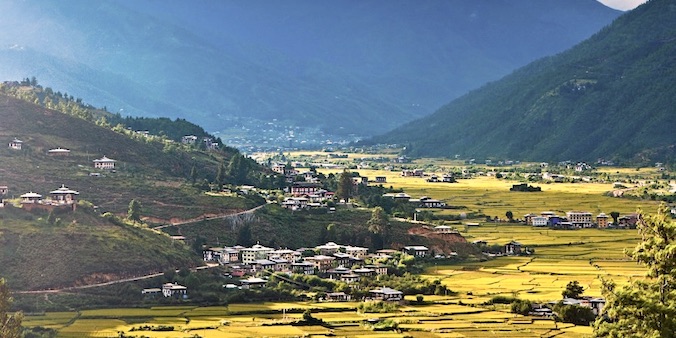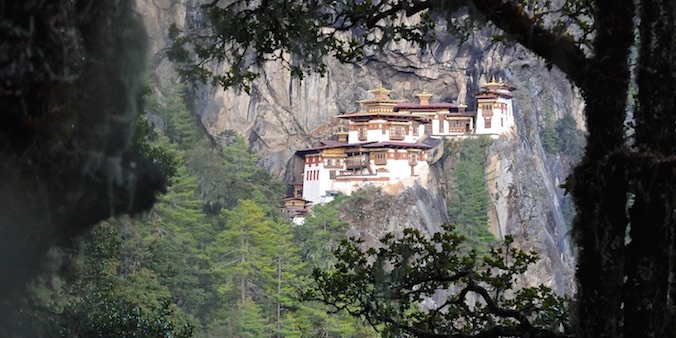WEST BHUTAN with SOI YAKTSA TREK
Tour - 18 days/ 6 days trekking
About BHutan
Bhutan is not your average destination. And that’s the understatement of the century. For starters, it’s the only remaining Buddhist Himalayan kingdom, the only one that managed to escape assimilation by either China or India. Being only the size of Switzerland and having just over 700,000 inhabitants, that’s quite a feat in itself.
Bhutan is mainly known for its very original culture and nature. This is largely due to the centuries of isolation, but also to the deliberate policies of the present government and of the kings in the past. Until the seventies, hardly any foreigner ever had set foot in the secluded kingdom.
Read more…Read less…
HAPPINESS OVER WEALTH
However, in 1972, at the occasion of the crowning of king Jigmed Singye Wangchuk, many foreign guests were invited to Bhutan. Having studied in the U.K., the future king obviously saw it coming that especially the western guests would observe a discrepancy between their own standard of living and that of the Bhutanese. In his opinion, the Bhutanese were not poor, but merely lacking in some amenities and products available in the West, most of them non-essential. Otherwise, the Bhutanese were actually quite well off, he felt. Almost all of them had a beautiful, spacious farmhouse, more than enough forests, arable land and animals to be fully self-sufficient in terms of heating, construction and nourishment. And, most importantly, a culturally defined sense of identity, belonging and security that made most of them very content and happy beings. The king had observed otherwise in the west.
In order to explain this to his foreign guests, he coined the term ‘gross national happiness,’ a clever term obviously meant to be juxtaposed with what seemed to be the aim of most governments, a high gross national product. The rest is history, one could say. These days, all over the world, conferences and workshops are being held on happiness and, more in general, on how to develop and emphasize those qualities of life that can not be measured in dollars or euros.
Bhutan does not claim that its inhabitants are the happiest in the world, but it does place overall happiness above wealth. These days, GNH, as it is generally referred to, is the formal pillar and yardstick of all government policies. After the king abdicated his powers in favor of a democratically elected government, Bhutan has seen four governments. All of them have continued to place GNH above anything else.
As a result, Bhutan has protected its culture – largely defined by Buddhist beliefs – but also its forests, mountains, rivers and wildlife much better than any other country in Asia. Key to all this is a reliable, non-corrupt government, which itself is one of the four pillars of GNH and, frankly, quite the exception in the region.
On your trip through Bhutan you will see numerous temples, monasteries and dzongs (monastery castles), better preserved and more lavishly decorated than anywhere else in the ‘Tibetan’ realm. Not less impressive, if alone because of their rustic beauty, are the many traditional houses, as well as meeting the friendly, warm-hearted people who embrace their culture as a precious heritage.
Read more…Read less…
Bhutan is also extremely mountainous and rich in nature, especially forest – in fact, it is the most wooded country in Asia. The southern border consists of hills and low mountains with dense jungle where elephants and tigers roam, and people live in bamboo houses surrounded by rice fields. But in the central highlands, at an altitude of 1500 – 2500m, people live in small enclaves of farms reminiscent of Swiss chalets, surrounded by endless coniferous forests. Travelling through this area (and when you fly over it) you will occasionally catch a glimpse of the northern and highest parts, where the semi-nomadic yak shepherds live and which are bordered by glacier-covered Himalayan peaks. The only way to see all this up-close is to set out on a seven-day (or more) camping trek. This is exactly what you’ll be doing on this tour.
Region
Bhutan
Best Time
April-May &
Oct-Dec
No. Of Days
18 days, 6 days trek
Trip Character
Jeep tour with trek
Sleeping Altitude
1400 - 4090 m
Trek Character
Camping trek
Level: 3
Price
INR XXX/ $ XXX
ABOUT THIS TOUR
On this tour you’ll first see the highlights of western Bhutan, such as Thimphu, Paro, Punakha, Haa and the famous Tigersnest Monastery (Taktsang Gompa.
Then you se out on a trek of 7 days over the southern flanks of the Himalayan Range. You will pass remote villages and yak herder camps and come face to face with 7314m high Mt. Jomolhari and 6989m high Mt. Jichu Drake, the two highest mountains in this region.
This is a shortened version of the famous 9-day Jhomolhari trek, and very suitable for those who want to get the same high Himalayas feel as you’ll get on the Jhomolhari trek but don’t have the time to do the full 9-day trek.
YOUR custom-made TRIP
The tour described here, as well as the other ones on our website, are mainly meant as suggestions. We would be happy to offer you a travel proposal that fully meets your personal demands and expectations. That means that you choose where you want to go, what level of accommodation and type of transport you want and what activities you prefer.
Please let yourself be inspired by this and other trips on our website and then drop us a line (or call us up) to explain your travel wishes. We will be happy to help you put together the perfect trip. You can reach us over e-mail, Messenger, Whatsapp or mobile phone.
EXTENSIONS & VARIATIONS
Apart from the tour as described here, you could consider the following add-ons and changes:
- Spend another day in Thimphu, for instance at the end of the tour. Because, although Thimphu is by far Bhutan’s most ‘mundane’ place, it has a lot to offer in terms of culture, restaurants and cafes, shopping, and a very pleasant atmosphere.
- Do a short trek which takes of the beaten track, along time-warped villages and high yak pastures. For instance a two-day trek in Bumthang, from Jakar to Tang and over de Phephe La (pass) to Nang Lhakhang. Or the three-day Saga La Trek from Haa upto the Che La pass. On longer treks (seven days minimum) you can get up-close with the Himalayan giants, such as Mt. Jhomolhari (7326m). For the latter, see here.
- Spend a day rafting on the Paro River. There are different grades available, so there is the easy-but-fun-to-do level as well. Professional oarsmen will be with you in any case. You will be picked up from your hotel and dropped off there again at the end of the day, a pic-nic lunch is included.
ITINERARY
-
.fa-info {color: #1146a9;}.fa-info:hover {color: #387dff;}Day 1: Delhi ✈︎ Paro & drive to Thimphu (1.5 h)
The flight to Paro (Bhutan) takes less than 2,5 h and, in clear weather, affords wonderful views of the Himalayas, including Mt. Everest (8848m) and Kangchenjunga (8568m). At the airport our guide and driver await you outside the airport, and will take you to Thimphu, the capital. On this short drive, you'll get a first glimpse of Bhutan's forests and rustic, half-timbered houses. Altitude 2350m. a:hover {color: #1146a9; background-color: transparent; text-decoration: underline; } -
Day 2: In Thimphu
You have the whole day to explore Thimphu. Besides the many options listed in the highlights below, you can visit the archery range and the animal park with the takin, the national animal of Bhutan. Or you can walk to a nearby monastery in the woods with beautiful views. Altitude 2350m. -
Day 3: Thimphu - Punakha (2.5 h)
Driving eastwards over the only road that connects the capital with middle and East of Bhutan you'll cross the 3120m high Dochu La (‘La’ = ‘pass’). Here, you get beautiful views of the Himalayas, before descending to the relatively warm Punakha valley. Altitude 1400m. -
Day 4: In Punakha
Today, you'll explore several sights of Punakha, most importantly Punakha's magnificent dzong. A dzong is a uniquely Bhutanese and Tibetan phenomon. It is a monastery, district administration office and (in the past) military fort at once. Altitude 1400m. -
Day 5: Punakha - Phobjikha
Traveling further to the east, you reach the beautiful, high valley of Phobjikha. Altitude 1400 → 2900m. -
Day 6: In Phobjikha
Phobjikha is a protected conservation area where black-necked cranes live. On a walk through the valley you hopefully will see the cranes. And you visit Gangte Goemba (goemba=monastery), belonging to the Nyingmapa, the oldest Buddhist sect in Bhutan and Tibet. Altitude 2900m. -
Day 7: Phobjikha - Haa (8 h)
A rather long ride takes you back to Thimphu and further west. Halfway Thimphu and Paro, at Chuzom, you take one of the most scenic routes in the country to the very authentic Haa valley. Altitude 2900 → 2670m. -
Day 8: In Haa
Today you’ll visit Lhakhang Kharpo, the largest temple in the area, and take several short walks in the countryside, visiting rustic villages and climb up to small, hidden monasteries. Altitude 2670m. -
Day 9: Haa - Paro
First we drive up to the Chele La (3988m) with fantastic views of the Himalayas. Then we hike down to a nunnery monastery, set dramatically at the foot of a steep cliff. The car brings you to Paro. The afternoon can be spent on visiting the pleasant centre of Paro, the dzong and adjacent National Museum or maybe the medieval Kyichu Lhakhang (lhakhang=temple). Altitude 2670 → 2250m. -
Day 10: in Paro, walk to Tigersnest
Today you do the well-known hike to legendary Taktsang Goemba, better known as Tiger’s Nest. It is 2.5 h walking up and 1.5 h down, but the magical little temple is worth it. Altitude 2250 → 3120 → 2250m. -
Day 11: Paro - Drugyel Dzong -Shana (2 h)
The start of the 7-day trek used to be at Drugyel Dzong, one hour drive from Paro. As there is a dirt road now to the first trekking camp, most trekkers prefer to be dropped there. At the camp the trekking crew awaits you (cook & helper, horseman with packhorses). Altitude 2250 → 2870m. -
Day 12: Trekking Shana - Soi Thangthagkha (7 - 8 h)
The path climbs gradually up along the Paro river through forests of pine, oak and spruce and later on rhododendron. A side-trail once functioned as an important trade route to Tibet. Altitude: 2870 → 3630m. -
Day 13: Trekking Soi Thangthangkha - Jangothang (6 - 7 h)
During today’s climb we pass winter shepherd houses, perhaps yak herds with above tree line wonderful views of the snowy Himalayas. One of the most beautiful campsites in Bhutan is located under a dilapidated fortress at the foot of Jomolhari (7314m). Altitude 3630 → 4090m. -
Day 13: Trekking Soi Thangthangkha - Jangothang (6 - 7 h)
During today’s climb we pass winter shepherd houses, perhaps yak herds with above tree line wonderful views of the snowy Himalayas. One of the most beautiful campsites in Bhutan is located under a dilapidated fortress at the foot of Jomolhari (7314m). Altitude 3630 → 4090m. -
Day 15: Trekking Jangothang - Bontey La - Soi Yaktsa (7 h)
During this tough trekking day you first reach the twin lakes of Tshophu and encounter yak-herd camps and perhaps ibex-like blue sheep. Trekkers have also seen snow leopards here. After a long climb you reach the Bontey La (4760m) with enchanting panoramas of the Himalayas followed by a long descent. 4090 → 4760 → 3730m. -
Day 16: Trekking Soi Yaktsa - Tagulun La - Thombu Shong (6 h)
A gradual descent through a wooded area is followed by the quite strenuous climb to Tagulun La (4540m). From here you descend to a beautiful valley. Altitude: 4090 → 4540 → 4070m. -
Day 17: Trekking Thombu Shong - Thombu La - Shana (5-6 h) & drive to Thimphu
Soon Thombu La (4240m) is reached. During the long descent to Shana you partly follow a ridge with beautiful views on both sides. A short drive takes you to Thimphu. Altitude : 4070 → 4240 → 2870m → 2350m. -
Day 18: Thimphu – Paro & Paro ✈︎ Delhi
Transfer from Thimphu to Paro (1,5 h). A morning flight brings you from Paro to Delhi, hopefully again with wonderful views of the Himalayas. If you have asked us to arrange accommodation and transfers in Delhi you will be picked up from the airport by our driver.
HIGHLIGHTS OF THIS TOUR
Flight to Paro
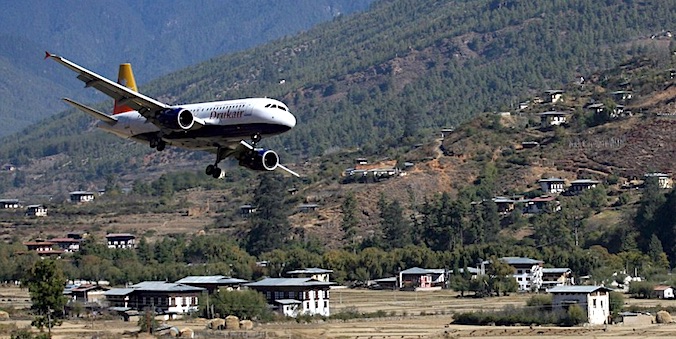
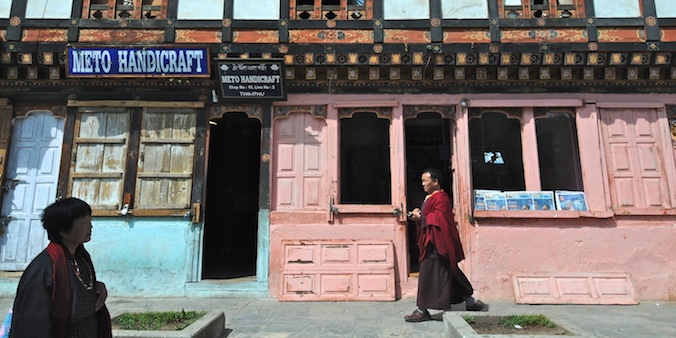
Thimphu
Sights of Thimphu
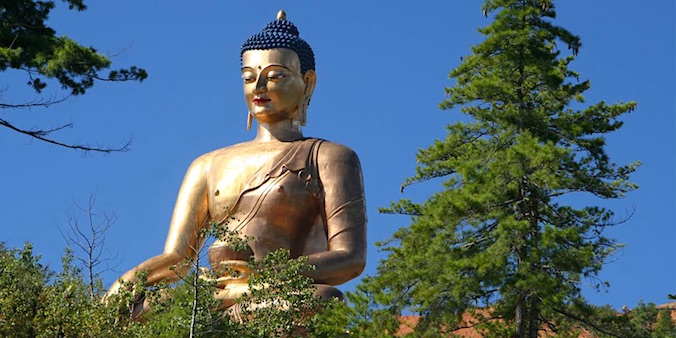
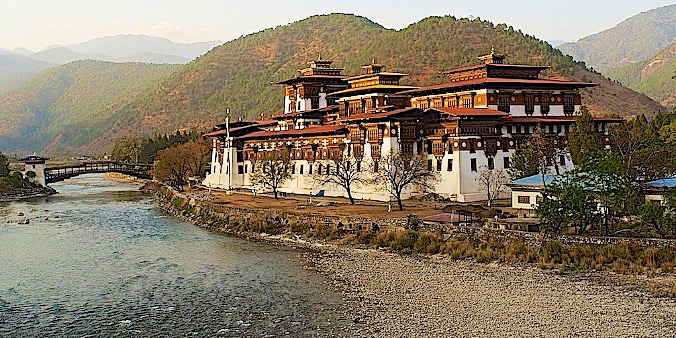
Punakha Dzong
Punakha - Other Sights
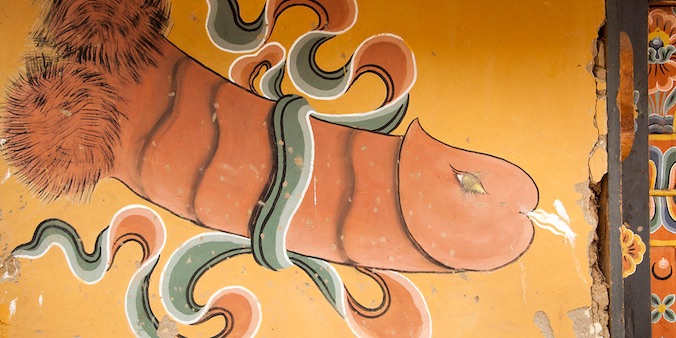
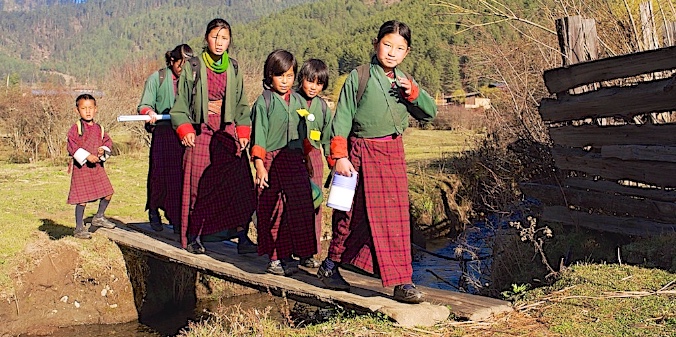
Phobjikha
Road Chuzom - HAA
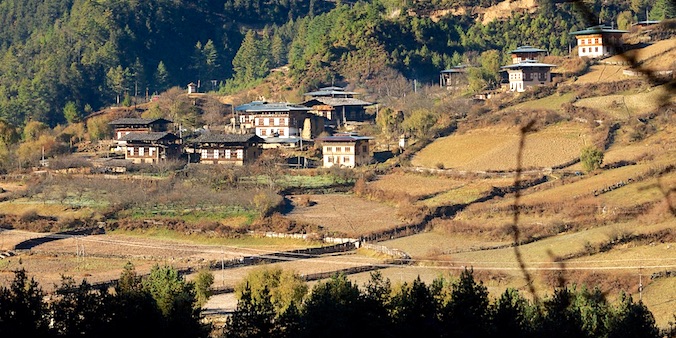
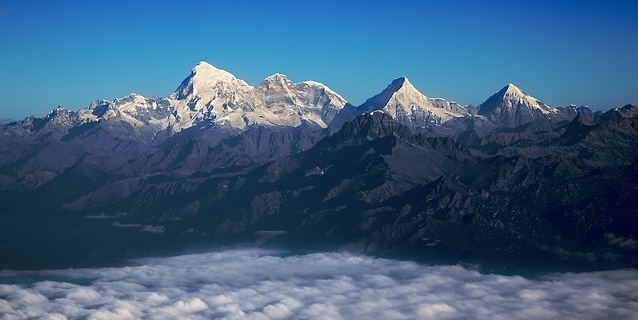
Chele LA
From the Haa Valley you climb to Bhutan’s highest motarable pass, the Chele La (3988m). The narrow road creeps up through magnificent forests of enormous cedars, spruces and larches, a well as tree-high rhododendrons (which normally bloom in April-May). Once up, weather permitting, you will be treated to beautiful views of the Himalayas, especially Mt. Jhomolhari (7329 m) right on the Tibetan border. The best view you get from the road, 100 m north of the pass. Descending, you reach the wide Paro Valley.
Paro
The dzong of Paro dates from 1644 and has a certain allure, not only because of its strategic location high above the valley, but also because of the massive utse (central tower), the richly carved and painted woodwork and the large prayer hall with beautiful murals. The adjoining brand-new and temporary national museum has many instructive panels, models, etc. Also very worthwhile is the Kyichu Lhakhang, one of the two oldest temples of Bhutan. Like the Jambey Lhakhang in Bumthang, it dates back to the year 659, and it would be part of the same 108 temple project of Tibetan King Songtsen Gampo. Also well worth a visit is the main street of Paro with colourfully painted shops and local cafes
